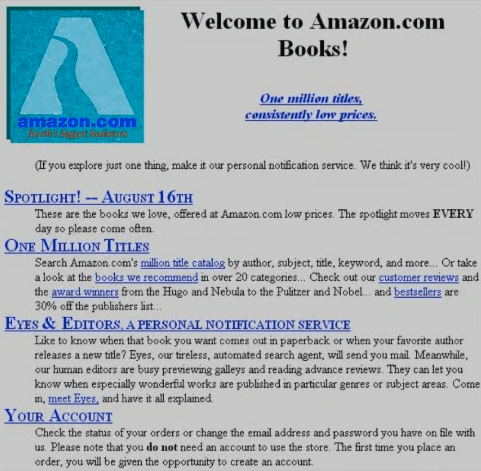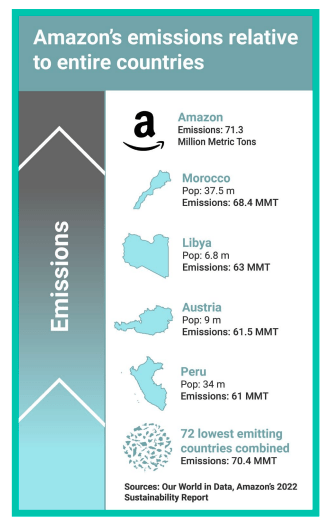Oh Amazon. Why do you have to be like this?
How did an ugly 90s website selling books come to be such a supervillain? This is a company truly set on world domination: from creepy humanoid delivery bots and a third of the internet’s cloud computing services to physical grocery shops, publishing books, and delivering prescription drugs. Amazon is taking over.
Perhaps you’ve felt a little uncomfortable with Amazon for a while but needed a helping hand to quit? Amazon has wriggled into our lives in so many ways that it can feel awkward and inconvenient to break away. We offer up this pair of blog posts as an opportunity to reflect on whether our relationship with Amazon still feels good, and ask how our choices can influence others.

In the first part of this blog we’ll explore the issues with Amazon; there are so many issues with the way the company operates that we’re going to take them one at a time. If you don’t need persuading and you’re ready to take the plunge click here to skip this part and jump straight to the ‘how to’!
Five signs you might be in a toxic relationship 🥀
Are you noticing red flags? You might be in a toxic relationship with a multi-national commerce platform if…
It has a supersized carbon footprint.
Over the last few years Amazon has churned out a lot of climate PR; at the same time their emissions have been rising. Amazon is now producing more climate pollution than the whole of Morocco or, to put it another way, you could take a long haul flight every day for 94,000 years and you still wouldn’t have produced as much climate pollution as Jeff Bezos.
Want that in numbers? In 2024, Amazon’s emissions rose to 68.25 million metric tonnes of climate pollution, a 6% increase from the previous year and an increase of… wait for it…. 162% since announcing their Climate Pledge in 2019.Fuel and refrigerant for deliveries and power use and building materials for their ever expanding data centres are the greatest sources of Amazon’s emissions.

What’s more, the way they report their emissions means they’re almost certainly massively undercounting them, and of course their figures don’t include the manufacture or use of the vast majority of the products they sell. I read their 2024 sustainability report so you don’t have to and it’s a masterclass in greenwashing.
It harms its workers (and doesn’t care).
Around the world Amazon workers deal with appalling conditions, from working in unsafe heat, packing people into fulfilment centres at the height of the pandemic, making people work through a tornado, obsessive surveillance of its workers or causing staff to suffer serious physical and mental health crises. Last year thousands of Amazon workers in 20 countries went on strike on Black Friday in protest against the company’s refusal to pay workers properly, allow them to unionise, and pay its taxes properly.
Read more: Make Amazon Pay is a worker-led campaign to fight Amazon’s exploitation of workers, communities, and the planet.
It's a tax dodger
I guess we’ve all heard that Amazon doesn’t pay its taxes but the actual figures are shocking. Amazon are sneaky about publishing their finances so it’s hard to say exactly how much they’re dodging, but according to Ethical Consumer’s latest research Amazon should have paid around £433m in tax in 2023 but only paid around £18m, a tiny fraction of the amount that might be expected. They go on to describe several ways this money could have benefitted the country, for example…

- 1,443,333 additional winter fuel payments to the most vulnerable
- 12,735 additional nurses
- Insulating 61,857 homes
Amazon is the 3rd biggest UK retailer by sales but contributes around just 0.2% of the total corporation tax paid by UK businesses in 2023. As our public services fall to bits around us, this is rough.
Read more: Ethical Consumer have their eye on Amazon – read more of their research on tax dodging.
It controls your spending (and makes you buy more than you want to)
In May Amazon launched Amazon Haul. This is a section of its app and website that sells things at – in its own words – ‘crazy low prices’. The website – still in beta in the UK as I write this – is a bit full on. Emojis bounce, offers scroll, notifications pop up to tell you that you’re literally the last person in the universe without this unicorn fancy dress for dogs in their cart, you big loser. Amazon is increasingly leaning into the Shein and Temu model: buy all the crap, right now.
Of course, Haul hasn’t replaced Amazon Prime, the wildly popular subscription model, which uses deals and convenience to drive impulse purchases. And even bog-standard Amazon uses every trick in the book to get you to open your wallet, from one-click purchasing, AI- driven targeted recommendations, ads that stalk you across the internet and false scarcity tactics – “Only 1 dog fancy dress left in stock!”
Our world cannot handle our current level of shopping. Amazon is there to make us buy more than we need, and that’s got to change.
Watch: Buy Now! The Shopping Conspiracy on Netflix explores how Amazon and other mega companies are driving overconsumption. It’s got that classic Netflix documentary energy but it’s worth a watch.
It’s a massive waster
In 2021 it was revealed that Amazon was routinely destroying millions of unused and working items, including extremely carbon intensive products such as laptops, smart TVs and jewellery. In one week in April that year, a leaked document from inside an Amazon warehouse in Scotland warehouse showed more than 124,000 unsold items marked ‘destroy’; a manager admitted to ITV that in some weeks, it was as many as 200,000 items.
Why do they do it? When you have a business model based on getting stuff to people as quickly as possible, shelf space in a warehouse becomes more valuable than the items themselves, so anything deemed less likely to sell is destroyed.
Packaging remains an issue too. Despite efforts in some parts of the world to reduce plastic packaging, in other areas it is increasing – in 2022 (the most recent figure available) Amazon’s plastic packaging in the US increased 9.8%. Research from Oceana suggests that up to 9.9m kg of Amazon’s global plastic packaging from 2022 will have ended up in the world’s waterways and seas. Yuck.
And there we have all the reasons that Amazon su… no wait there’s more!
- Supplying technology to the Israeli military
- Failing to play suppliers on time
- Failing to act on forced labour/ modern slavery
- Bullying and pricing out small businesses
- Stealing data from independent businesses using its platform and using to it promote its own products
- Lobbying against laws that would require it to behave less horribly
- Collecting masses of personal data, being cagey about how it’s used (or shared or sold) and making moves into surveillance.
- Complying with various governments demands for censorship; effectively banning books.
- Causing massive environmental harm while filming their blockbusters – this horrifying article describes the waste generated in the filming of The Rings of Power.
- Causing kids called Alexa to get bullied
- And we could go on but I think we all get the idea…
Amazon: It’s not me, it’s you 💔
This relationship is manipulative, controlling, and it’s sucking us dry. We deserve better. That’s why we’re framing this as a break up, not a boycott; when we boycott, we withdraw our money from a business until they drop a harmful practice, but with Amazon this isn’t going to happen, the whole model is dodgy and destructive. A clean break lets us experience freedom and realise we never needed Amazon anyway.
I decided to break up with Amazon in 2017; I was a prime user and relied on it pretty heavily, especially as I had a small baby. It was a habit and I didn’t give it a lot of thought to be honest, it was just there. But in 2017 I decided to try an experiment: could I do all my Christmas shopping without using Amazon? At the time this felt like kind of a big deal and a little nerve wracking. Was it going to be a lot of extra work? Or really expensive? To my surprise it was a much nicer experience and perfectly easy. By the end of December I had cancelled Amazon prime and I never used it again. And it. Felt. Great.

Now of course this is just my experience, and admittedly I just shopped on Amazon, I wasn’t tied in to any other Amazon services, such as an Alexa or Audible. With that in mind, it is worth saying that a full break up is easier for some people than others. Depending on how you use Amazon right now, you may find you need to take it step by step, or just reduce your Amazon use (which is still an amazing choice); don’t worry, we’ll cover everything you need to know in part two of this blog.



